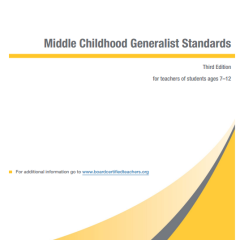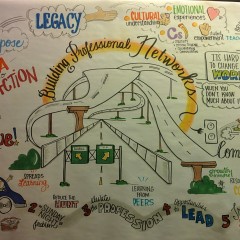One of the most profound professional development activities I took part in this summer was attending the Professional Learning Communities at Work Institute in Seattle with a large number of colleagues from my new building and across my district. We’ve all heard about PLCs and we’ve all been part of PLCs, but there were definitely some missing pieces in my understanding and implementation. (Read a short history of PLCs.) Maybe my story resonates with your experience.
A few years ago, I’m not quite sure how many, there were a set of four questions posted in the largest conference room at the district office, which also served as school board’s default meeting location (among other uses). Maybe they’re familiar?
- What do we want students to learn?
- How will we know if they have learned?
- What will we do if they don’t learn?
- What will we do if they already know it?
Good questions, but I had no idea where they came from or how I could use them. In fact I was a little suspicious of them because of the mystery that surrounded them. These questions seemed to show up everywhere. They were part of a number of school improvement plans and inexplicably appeared on collaboration forms my team was asked to fill out after working together.
A few years ago I was swept up in the Finland frenzy and was particularly struck by how much time teachers were able to collaborate during the regular school day. I already knew from my own experience that teachers needed more time to work together and I suspected that this was probably one of the reasons why the schools in Finland did so well. I joined a couple of PLCs and worked with teachers at my grade level, teachers from other schools, and teachers from across the grades interested in co-learning in my school. Still, I wasn’t totally clear on what the difference was between a group working together and a PLC. When I heard there was a conference on PLCs, I put my name in even though it was far off in the middle of the summer about nine months away.
INT. KITCHEN TABLE – NIGHT
Spencer writes a blog entry after the conference
So I’m here to tell you that I now believe that those four questions above are the secret to transforming public education. I wont be able to recreate the three day workshop with multiple keynotes and breakout sessions presented by some of the leading experts on PLCs working in education today, but I will explain those questions.
First of all, those questions form the cornerstone of the work that teachers in PLCs do together. They were articulated by Richard DuFour, Robert Eaker, and Rebecca DuFour. For further reading check out their books on PLCs.
Question 1: What do we want students to learn? This question is meant to be answered by teachers who collaborate together and work at the same grade level(s). These teachers must look at the standards and decide together what they guarantee that each of them will ensure that ALL students learn. What is non-negotiable? What, if not learned, would be disastrous for that student? Teachers need to commit to teaching those things as priorities. Not everything is of equal value. Teachers clarify and prioritize the standards together taking into account the intent of the standards and the needs of the students. This step can not be skipped, nor can it be mandated by above. This is where the team makes commitments to one another.
Question 2: How will we know if they have learned it? Now the teachers teach with the same objectives. They teach the best way each of them knows how. They decide on common formative assessments that will be given at approximately the same time. And when they have given those assessments and evaluated them, they come together to share their findings.
Question 3 & 4: What will we do if they don’t learn? What will we do if they already know it? These are the intervention and enrichment pieces, but there are a couple of important points to clarify if the PLC is to function properly. Firstly, we need to get vulnerable. Someone on your team will teach that particular concept most successfully and someone will teach it least successfully. Though there might be a nicer way to say that, this is where we feel threatened so we have to confront it. It must be visible so that the student learning can be addressed and this takes trust. Fundamentally, the teachers involved must see themselves as members of a team. Teachers in a PLC are not running side-by-side in a marathon, but rather rowing in the same boat (This was literally Rick DuFour’s analogy at the institute and it is a powerful shift in thinking). Secondly, the teachers need to take action with the information they obtain from looking at the results. That may include learning from the teacher who demonstrated the highest levels of student proficiency. It may also include having that teacher lead the intervention group for all of the students who have not learned. Nobody can meet the needs of all of their students by themselves. If we aren’t working as a team we don’t have a chance.
This process runs repeatedly and cycles through the key learning objectives for the students.
Time will be required and because we know it is a scarce commodity creativity will be necessary. One of the best ideas I have heard on creating time is to (occasionally) move the 30 minutes teachers are required to be available after school and combining it with the 30 minutes they are required to be there before school. In some cases you may be able to add an all-school activity to kick in another 15. All of this can be done without impacting buses, students, or families and could take place on a regular basis (with some contact negotiation).
This is the technical/structural shift, but the cultural shift may be the toughest to make (and hardest to recognize). This was brought to a very sharp point by Dr. Anthony Muhammad when he asked us to examine the achievement gap and equity from our own mindsets as well as within the de facto mindset of the system in general. More on this in another post…

 It always starts with a dream. A real dream; not an aspiration or goal, but the kind you have when you sleep. One year it was a poorly-executed field trip to Manhattan (with fourth graders) and another year I had a class of forty but no classroom. I was expected to teach them out on the lawn.
It always starts with a dream. A real dream; not an aspiration or goal, but the kind you have when you sleep. One year it was a poorly-executed field trip to Manhattan (with fourth graders) and another year I had a class of forty but no classroom. I was expected to teach them out on the lawn.

 My youngest son recently announced he was thinking about becoming a teacher. “What are all the steps you have to go through?” he asked.
My youngest son recently announced he was thinking about becoming a teacher. “What are all the steps you have to go through?” he asked. I recently celebrated my 30th wedding anniversary, and as it happened, my wife and I attended a wedding three days later. While watching the wedding my thoughts naturally turned to the differences between a wedding and a marriage. It’s one thing to promise everything to your spouse; it’s another thing altogether to renew that promise year in and year out.
I recently celebrated my 30th wedding anniversary, and as it happened, my wife and I attended a wedding three days later. While watching the wedding my thoughts naturally turned to the differences between a wedding and a marriage. It’s one thing to promise everything to your spouse; it’s another thing altogether to renew that promise year in and year out.
